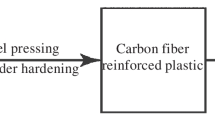Abstract
The electrical resistance of carbon-graphitic materials with different porosities (19–78%) was studied in the 300–1700‡K temperature range, and the results are presented here. It is shown that, in generalized coordinates, the thermal and the electrical conductivity are analogous functions of porosity.
Similar content being viewed by others
Literature cited
é. A. Bel'skaya and A. S. Tarabanov, Inzh. Fiz. Zh.,18, No. 4 (1970).
Okada, in: Graphite as a Refractory Material [Russian translation], Vol. 1, Mir, Moscow (1964), p. 65.
Hutcheon and Price, in: Graphite as a Refractory Material [Russian translation], Vol. 1, Mir, Moscow (1964), p. 320.
A. I. Lutkov, in: Design Materials Based on Graphite [in Russian], Vol. 4, Metallurgiya (1968), p. 67.
J. C. Maxwell, Treatise on Electricity and Magnetism, Oxford (1873).
Lord Rayleigh, Phil. Mag.,34, 481 (1892).
A. L. Loeb, J. Appl. Phys.,22, 252–285 (1951).
G. S. Son Frei, Z. Elektrochem.,38, 260 (1932).
G. N. Dul'nev, Inzh. Fiz. Zh.,9, No. 3, 399 (1965).
Author information
Authors and Affiliations
Additional information
Translated from Inzhenerno-Fizicheskii Zhurnal, Vol. 20, No. 4, pp. 654–659, April, 1971.
Rights and permissions
About this article
Cite this article
Bel'skaya, é.A., Tarabanov, A.S. Experimental studies concerning the electrical conductivity of high-porosity carbon-graphitic materials. Journal of Engineering Physics 20, 472–475 (1971). https://doi.org/10.1007/BF00826816
Received:
Issue Date:
DOI: https://doi.org/10.1007/BF00826816




